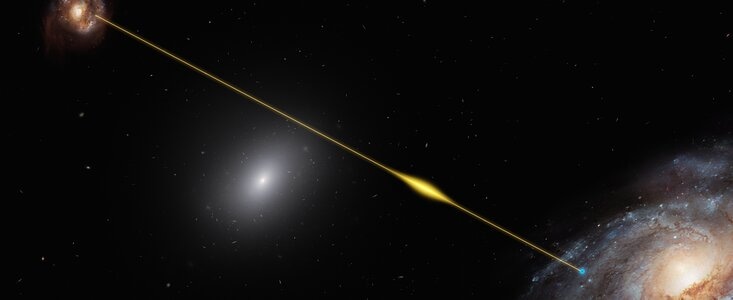Sep 27 2019
For the first time, astronomers have noticed that a fast radio burst passed through a galactic halo. They observed this with the help of ESO’s Very Large Telescope (VLT).
 Artist’s impression of a fast radio burst traveling through space and reaching Earth. (Image credit: ESO/M. Kornmesser)
Artist’s impression of a fast radio burst traveling through space and reaching Earth. (Image credit: ESO/M. Kornmesser)
The mysterious blast of cosmic radio waves lasted less than a millisecond and came through nearly undisturbed, indicating that the halo has an astonishingly weak magnetic field and low density. The evasive halos of other galaxies can be explored by using this new approach.
The astronomers used one cosmic mystery to investigate another and analyzed the signal from a fast radio burst to gain insights into the diffuse gas in the halo of a massive galaxy. The Australian Square Kilometre Array Pathfinder (ASKAP) radio telescope located a fast radio burst, called FRB 181112, in November 2018.
Through further observations with ESO’s VLT and other telescopes, it was observed that the radio pulses already passed through a massive galaxy’s halo while traveling toward Earth. This discovery enabled astronomers to examine the radio signal for hints related to the nature of the halo gas.
The signal from the fast radio burst exposed the nature of the magnetic field around the galaxy and the structure of the halo gas. The study proves a new and transformative technique for exploring the nature of galaxy halos.
J. Xavier Prochaska, Professor of Astronomy and Astrophysics, University of California Santa Cruz
Prochaska is also the lead author of a paper describing the new outcomes. The paper was published in the Science journal on September 26th, 2019. To date, astronomers are unaware of what produces fast radio bursts. Only recently have they been able to track a few of these very short, very bright radio signals back to the galaxies where they originated.
When we overlaid the radio and optical images, we could see straight away that the fast radio burst pierced the halo of this coincident foreground galaxy and, for the first time, we had a direct way of investigating the otherwise invisible matter surrounding this galaxy.
Cherie Day, Study Coauthor, PhD Student, Swinburne University of Technology
A galactic halo is formed of both dark and ordinary (or baryonic) matter that mostly exists in the form of hot ionized gas. Although the diameter of the luminous part of an enormous galaxy might be nearly 30,000 light-years, the diameter of its almost spherical halo is 10 times larger.
Star formation is driven by halo gas when it falls toward the center of the galaxy. By contrast, other processes like supernova explosions can discharge material out of the star-forming areas and into the galactic halo. The main reason astronomers intend to investigate the halo gas is to gain better insights into these ejection processes that can disable star formation.
“This galaxy’s halo is surprisingly tranquil,” stated Prochaska. “The radio signal was largely unperturbed by the galaxy, which is in stark contrast to what previous models predict would have happened to the burst.”
Each of the few pulses of the signal from FRB 181112 lasted less than 40 μs (10,000 times shorter compared to the blink of an eye). The short duration of the pulses places an upper limit on the halo gas density since crossing through a denser medium would widen the radio signal’s duration.
According to the researchers’ calculations, the halo gas density must be less than 0.1 atoms per cubic centimeter (comparable to several hundred atoms in a volume the size of a child’s balloon).
Like the shimmering air on a hot summer’s day, the tenuous atmosphere in this massive galaxy should warp the signal of the fast radio burst. Instead we received a pulse so pristine and sharp that there is no signature of this gas at all.
Jean-Pierre Macquart, Study Coauthor, Astronomer, International Center for Radio Astronomy Research, Curtin University
The research did not find any evidence of small dense clumps of cool halo gas or cold turbulent clouds. The signal from the fast radio burst also offered information related to the magnetic field in the halo. This magnetic field is very weak—a billion times weaker compared to that of a refrigerator magnet.
At this stage, with outcomes from only a single galactic halo, the astronomers will not be in a position to say if the low magnetic field strength and low density they measured are strange, or whether previous research into galactic halos has overestimated these properties. Prochaska expects fast radio bursts will be used by ASKAP and other radio telescopes to explore many more galactic halos and find out their characteristics.
“This galaxy may be special,” added Prochaska. “We will need to use fast radio bursts to study tens or hundreds of galaxies over a range of masses and ages to assess the full population.”
Optical telescopes such as ESO’s VLT have a crucial role to play in that they show how far away the host galaxy of each burst is located, and also whether the burst would have traveled through the halo of any galaxy in the foreground.